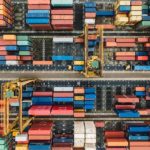A view of the Gippsland Lakes
Are we failing to protect the natural world? Max Thomas says we need to understand that the value of life and the natural systems is priceless.
The Gippsland Lakes in eastern Victoria are among the best known and popular of Victoria’s environmental and tourism resources. The Lakes are a series of lagoons that once consisted of mainly fresh water supplied by the Avon, Thomson, Latrobe, Mitchell, Nicholson and Tambo rivers. Since the opening of an entrance to Bass Strait in 1889, the Lakes have become more estuarine in character with profound ecological effects.
The Lakes are a biologically diverse ecosystem and are an important destination for many migratory bird species protected by international agreements. [1] Like other water bodies, the Gippsland Lakes reflect the condition of their catchments and the effects of past management. Drastic changes in the catchments and the opening of the entrance to the sea released ecological forces that are almost impossible to reverse.
I once had the privilege of visiting the Gippsland Lakes in the company of the eminent geomorphologist Dr Eric Bird. Dr Bird had a deep understanding of the Lakes from his extensive studies over a long period. But, as it is with relationships of other kinds, it seemed to me that his understanding of the Lakes had grown into something perhaps akin to that mysterious bond between indigenous people and their environment.
I am a Gippslander who loves the Lakes. I recently saw the beautifully filmed video “Love our Lakes” which was produced for the Gippsland Lakes Ministerial Advisory Committee. The video is more like a travel promotion than a wide-ranging and factual account that might be expected to emerge from a process aimed at formulating an Environmental Strategy for the Lakes. The video apparently aims to, and succeeds, in showing that the Lakes aren’t ‘dead’. However, in the absence of any reference to water quality, blue-green algae and the degradation of shorelines and wetlands by salinity, the video is misleading. The problems of the Lakes must be acknowledged and widely understood before significant progress will be made with improvements in the catchment areas. The video looks like an attempt to ‘reform’ public opinion by means of familiar PR techniques. In the present era, people gather much of their information from powerful visual images and not so much from reading. The subliminal message is that all is well with the Lakes, carry on with business as usual; but it’s not that simple.
The message conforms to the ideal of the Lakes consisting of clear, blue water surrounded by sandy beaches. This vision of the Gippsland Lakes is utterly unlike the pre-European reality when the Lakes where predominantly fresh water lagoons fringed by reeds with adjacent extensive wetlands and deep fresh water marshes. To be fair, there’s a lot more information at the “Love our Lakes” web page for anyone who wants to go below the surface.
I am not confident that governments have the will or capacity to convince the population of the need to change their behaviour and to divert financial resources to Gippsland Lakes catchment improvements. We have been borrowing from what I will call the ‘ecobank’ since European settlement and, far from repaying the loan, we haven’t even been paying interest. Whether or not Dr Bird would agree with this assessment I cannot tell, but I feel sure he would recognise a familiar and disturbing pattern of bureaucratic rationalisation. He left with me a lasting impression by saying – and I paraphrase: ‘As much as I love the Gippsland Lakes, I would prefer them in their present degraded state than to trust any government with the power they would need to intervene at the household level to restore them.’
It is arguably the aggregate, some say tyranny, of multiple small decisions that result in ecocide. ‘Developers’ today create incremental landscape changes that become tomorrow’s environment, like so many settlers hacking away at the bush in the Strzelecki Ranges, breaking their backs to eke out a living. After several generations all the clearings linked up leaving only remnants here and there to remind us of what has been lost.
Until recently there was a sign near Thorpdale indicating the site of what was once reputedly the world’s tallest flowering plant. Presumably, the plant was a Mountain Ash tree (E. Regnans). Legend has it that the tree was felled to measure its height. Apocryphal or not, a simple measurement and calculation might have saved a lot of effort and a somewhat dubious historical distinction. Clearing forests on a vast scale and replacing them with pastures for animals; draining wetlands and planting crops; building dams, cities and roads; altering the course of rivers; dredging, mining, making a living and recreating. Directly or indirectly, sooner or later, there is a price to pay for these things beyond what can be valued in money.
‘Externalities’ are costs or benefits affecting anyone who did not choose to incur them. For example, power generation, agriculture and timber-related industries in Central Gippsland cause changes in local land, air and water that impact upon the quality of life of the local population and the Gippsland Lakes while producing substantial benefits for the population of the State of Victoria and beyond.
‘The Tragedy of the Commons’ describes the dilemma of many individuals acting rationally and separately in their own self-interest, knowing that a shared and limited resource, such as the Gippsland Lakes, will ultimately be depleted or altered against the best interests of all. An individual who chooses to forego self-interested activity for the benefit of the Lakes will be disadvantaged – therein lies the tragedy.
Most people would be familiar with the concept of placing a monetary value on carbon. In this model, a ‘price signal’ provides an incentive for firms to abate their carbon emissions to the atmosphere. By contrast, direct regulation would attempt to force industries to adopt common standards regardless of economic efficiency. But can or should a price tag be placed on environmental intangibles such as a view, tranquillity or birdsong?
George Monbiot [2] delivered the 2014 SPERI Annual Lecture titled: “ The Pricing of Everything”, hosted by the Sheffield Political Economy Research Institute at the University of Sheffield. He had this to say about the development of what could be called the ‘Natural Capital Agenda’: “The pricing, valuation, monetisation, financialisation of nature in the name of saving it. Sorry, did I say nature? We don’t call it that any more. It is now called natural capital. Ecological processes are called ecosystem services because, of course, they exist only to serve us. Hills, forests, rivers: these are terribly out-dated terms. They are now called green infrastructure. We now call them asset classes in an ecosystems market. I am not making any of this up. These are the names we now give to the natural world.”
“Those who support this agenda say: We are failing spectacularly to protect the natural world – and we are failing because people aren’t valuing it enough. Companies will create a road scheme or a supermarket – or a motorway service station in an ancient woodland on the edge of Sheffield – and they see the value of what is going to be destroyed as effectively zero. They weigh that against the money to be made from the development with which they want to replace it. So if we were to price the natural world, and to point out that it is really worth something because it delivers ecosystems services to us in the form of green infrastructure and asset classes within an ecosystems market (i.e. water, air, soil, pollination and the rest of it), then perhaps we will be able to persuade people who are otherwise unpersuadable that this is really worth preserving.”
Monbiot went on to say: “The UK department for environment, when it launched the National Ecosystem Assessment in 2011, said it had established ‘the true value of nature for the very first time’. Unfortunately it wasn’t yet able to provide a figure for ‘the true value of nature’, but it did manage to provide figures for particular components of that value of nature. It said that if we looked after our parks and greens well they would enhance our well-being to the tune of £290 per household per year in 2060. What does it mean? [The Department] maintained that the increment in well-being is composed of ‘recreation, health and solace’; natural spaces in which ‘our culture finds its roots and sense of place’; ‘shared social value’ arising from developing ‘a sense of purpose’ and being ‘able to achieve important personal goals and participate in society’ enhanced by ‘supportive personal relationships’ and ‘strong and inclusive communities’. So you put solace and sense of place and social value and personal goals and supportive personal relationships and strong and inclusive communities all together into one figure and you come out with £290 per household per year. All we require now is for the Cabinet Office to give us a price for love and a true value for society and we will have a single figure for the meaning of life.”
There are signs that such a paradigm is taking hold in Australia. I like to think we are capable of understanding that the value of life and the natural systems that support it in perpetuity are priceless.
- Gippsland Lakes Shore Erosion & Revegetation Strategy Final Report. Gippsland Coastal Board, June 2002.
- George Monbiot studied Zoology at Oxford. After a time with the BBC Natural History and World Service units, he set out on adventures in Africa, Brazil, Indonesia and Papua. Monbiot is now a journalist with The Guardian and the author of the bestselling books The Age of Consent: A Manifesto for a New World Order and Captive State: The Corporate Takeover of Britain, as well as the investigative travel books Poisoned Arrows, Amazon Watershed and No Man’s Land.

Max Thomas, Dip. Agric. (retired) worked in the public sector and in private consulting on a range of land, water and waste management projects. He prepared guidelines for irrigation with recycled water for EPA Victoria and developed a number of Environmental Management Systems in the water industry.













